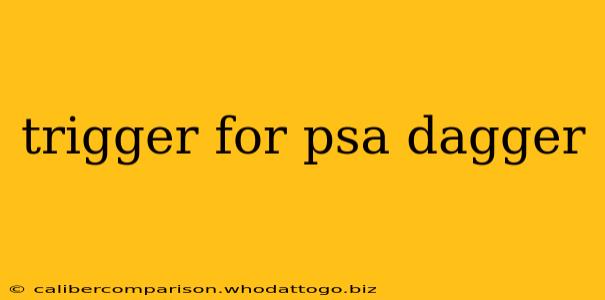The PSA Dagger, a popular and highly-regarded pistol, is known for its reliability and accuracy. Understanding its trigger mechanism is crucial for both safe handling and optimal performance. This guide delves into the intricacies of the PSA Dagger trigger, exploring its components, common modifications, and troubleshooting tips.
Understanding the PSA Dagger Trigger Mechanism
The PSA Dagger utilizes a striker-fired mechanism, meaning there's no hammer to cock. The trigger directly engages the striker, releasing it to fire the cartridge. This design contributes to the pistol's relatively short and light trigger pull, which is a key characteristic appreciated by many shooters. However, this also means that understanding the nuanced workings of the trigger is paramount for safe gun handling.
Key Components of the PSA Dagger Trigger:
- Trigger Bar: This component connects the trigger to the striker. Its movement directly controls the release of the striker.
- Striker: The striker is the firing pin; it's the component that ignites the primer when the trigger is fully depressed.
- Trigger Safety: Integrated into the trigger mechanism, this safety prevents accidental discharge. It's crucial to understand how this safety functions.
- Disconnector: This prevents the gun from firing more than one round with a single trigger pull.
- Sear: This interacts with the striker to hold it in place until the trigger is fully depressed.
Common PSA Dagger Trigger Modifications and Upgrades
Many shooters choose to modify their PSA Dagger triggers to enhance performance and personalize their shooting experience. These modifications range from simple adjustments to more involved replacements.
Trigger Spring Changes:
Replacing the trigger spring can impact trigger pull weight and reset characteristics. A lighter trigger spring will result in a lighter trigger pull, but it could also impact reliability. Conversely, a heavier trigger spring may improve reliability at the cost of a heavier trigger pull. Always proceed with caution when modifying internal trigger components and only use parts specifically designed for your model of PSA Dagger.
Aftermarket Trigger Upgrades:
Several aftermarket companies produce drop-in trigger kits designed for the PSA Dagger. These kits often offer improvements in trigger pull smoothness, weight, and reset. These upgrades can significantly improve the shooting experience but require careful installation to ensure proper functionality and safety. Improper installation can lead to malfunctions and potential safety hazards. Consider the expertise required before undertaking this type of modification.
Troubleshooting Common PSA Dagger Trigger Issues
While generally reliable, occasional issues can arise with the PSA Dagger trigger.
Heavy or Gritty Trigger Pull:
A heavy or gritty trigger pull may indicate the need for lubrication or cleaning. Disassemble the trigger group carefully, clean it thoroughly, and re-lubricate using a high-quality gun lubricant. If the problem persists, it could indicate a more serious issue requiring professional attention.
Trigger Reset Issues:
If the trigger fails to reset properly, it could be due to improper lubrication, dirt, or a damaged trigger part. Careful inspection and cleaning are often the first steps in troubleshooting.
Failure to Fire:
This is a critical issue. If the pistol fails to fire, it could be due to several reasons, including a faulty primer, a problem with the ammunition, or a malfunction in the trigger mechanism. Safety checks are paramount, followed by a careful examination of the firearm and ammunition. If the problem cannot be easily identified, seek professional assistance.
Disclaimer:
This guide provides general information. Modifying firearms can be dangerous and should only be performed by individuals with the necessary knowledge, skills, and experience. Always prioritize safety and consult with qualified professionals if you have any doubts or encounter problems. Improper modification can render your firearm unsafe and void any warranties. Remember to always follow all applicable laws and regulations regarding firearm ownership and modifications.

